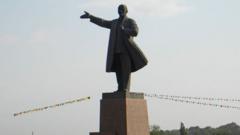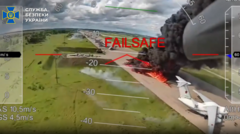In a noteworthy step towards redefining its national narrative, Kyrgyzstan has dismantled a prominent symbol of its Soviet past, removing the tallest Lenin statue in Central Asia from the city of Osh.
Kyrgyzstan Removes Central Asia's Iconic Lenin Statue

Kyrgyzstan Removes Central Asia's Iconic Lenin Statue
Kyrgyzstan bids farewell to its tallest Lenin statue, signaling change in national identity.
The Kyrgyz authorities have taken down a giant statue of Soviet leader Vladimir Lenin, marking a pivotal shift in the country's approach to its Soviet history. This towering 23-meter monument, a familiar sight in Osh for half a century, was removed last week as the nation seeks to reshape its identity following its independence from the Soviet Union 34 years ago. Photos shared online show the statue lying on the ground after being lowered by a crane, highlighting the ceremonial aspect of its removal.
While officials have cited aesthetic improvements as the rationale behind the statue's removal, many observers understand this as part of a broader trend among former Soviet republics to distance themselves from their past affiliations with Russia. This move is particularly significant given Russia’s recent unveiling of a statue of Josef Stalin in Moscow, indicating the delicate balance in Kyrgyzstan's relationship with its neighbor.
City Hall in Osh stated that the statue will be relocated, aligning with “common practice” aimed at enhancing the city’s architectural landscape. The plan aims to replace the monument with a flagpole, mirroring similar decisions made elsewhere, such as in the capital city, Bishkek.
Kyrgyzstan's landscape still echoes its Soviet heritage, with reminders such as Lenin Peak, the nation’s second-highest mountain. The removal of the statue underscores the ongoing transformation and the importance placed on redefining national identity in Central Asia.
While officials have cited aesthetic improvements as the rationale behind the statue's removal, many observers understand this as part of a broader trend among former Soviet republics to distance themselves from their past affiliations with Russia. This move is particularly significant given Russia’s recent unveiling of a statue of Josef Stalin in Moscow, indicating the delicate balance in Kyrgyzstan's relationship with its neighbor.
City Hall in Osh stated that the statue will be relocated, aligning with “common practice” aimed at enhancing the city’s architectural landscape. The plan aims to replace the monument with a flagpole, mirroring similar decisions made elsewhere, such as in the capital city, Bishkek.
Kyrgyzstan's landscape still echoes its Soviet heritage, with reminders such as Lenin Peak, the nation’s second-highest mountain. The removal of the statue underscores the ongoing transformation and the importance placed on redefining national identity in Central Asia.






















